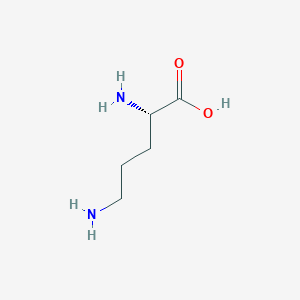| General Information of MET (ID: META00207) |
| Name |
Ornithine
|
| Synonyms |
Click to Show/Hide Synonyms of This Metabolite
(+)-S-Ornithine; (S)-2,5-Diaminopentanoate; (S)-2,5-Diaminopentanoic acid; (S)-2,5-Diaminovalerate; (S)-2,5-Diaminovaleric acid; (S)-Ornithine; (S)-a,D-Diaminovalerate; (S)-a,D-Diaminovaleric acid; (S)-a,delta-Diaminovalerate; (S)-a,delta-Diaminovaleric acid; (S)-alpha,delta-Diaminovaleric acid; 2,5 Diaminopentanoic acid; 2,5-Diaminopentanoic acid; 5-Amino-L-norvaline; L-(-)-Ornithine; L-Ornithine; Ornithine dihydrochloride, (L)-isomer; Ornithine hydrochloride, (D)-isomer; Ornithine hydrochloride, (DL)-isomer; Ornithine hydrochloride, (L)-isomer; Ornithine monoacetate, (L)-isomer; Ornithine monohydrobromide, (L)-isomer; Ornithine monohydrochloride, (D)-isomer; Ornithine monohydrochloride, (DL)-isomer; Ornithine phosphate (1:1), (L)-isomer; Ornithine sulfate (1:1), (L)-isomer; Ornithine, (D)-isomer; Ornithine, (DL)-isomer; Ornithine, (L)-isomer
|
| Source |
Endogenous;Escherichia Coli Metabolite;Yeast Metabolite;Food;Drug;Cosmetic;Food additives;Microbial
|
| Structure Type |
Amino acids, peptides, and analogues (Click to Show/Hide the Complete Structure Type Hierarchy)
Organic acids and derivatives
Carboxylic acids and derivatives
Amino acids, peptides, and analogues
|
| PubChem CID |
|
| HMDB ID |
|
| Formula |
C5H12N2O2
|
| Structure |
<iframe style="width: 300px; height: 300px;" frameborder="0" src="https://embed.molview.org/v1/?mode=balls&cid=6262"></iframe>
|
 |
|
3D MOL
|
2D MOL
|
|
Click to Show/Hide the Molecular/Functional Data (External Links/Property/Function) of This Metabolite
|
| KEGG ID |
|
| DrugBank ID |
|
| ChEBI ID |
|
| FooDB ID |
|
| ChemSpider ID |
|
| METLIN ID |
|
| Physicochemical Properties |
Molecular Weight |
132.16 |
Topological Polar Surface Area |
89.3 |
| XlogP |
-4.4 |
Complexity |
95 |
| Heavy Atom Count |
9 |
Rotatable Bond Count |
4 |
| Hydrogen Bond Donor Count |
3 |
Hydrogen Bond Acceptor Count |
4 |
| Function |
L-ornithine, also known as (S)-2,5-diaminopentanoic acid or ornithine is a member of the class of compounds known as L-alpha-amino acids. L-alpha-amino acids are alpha amino acids which have the L-configuration of the alpha-carbon atom. L-ornithine is soluble (in water) and a moderately acidic compound. It has been claimed that ornithine improves athletic performance, has anabolic effects, has wound-healing effects, and is immuno-enhancing. L-ornithine is abundant in a number of food items such as wild rices, brazil nuts, common oregano, and common grapes. L-ornithine can be found throughout most human tissues; and in most biofluids, some of which include blood, urine, cerebrospinal fluid (CSF), sweat, saliva, and feces. Within the cell, L-ornithine is located in the mitochondria and the cytoplasm. L-ornithine exists in all living species, from bacteria to humans. In humans, L-ornithine is involved in numerous metabolic disorders, some of which include, ornithine transcarbamylase deficiency (OTC deficiency), argininemia, and guanidinoacetate methyltransferase deficiency (GAMT deficiency). Moreover, Ornithine is found to be associated with cystinuria, hyperdibasic aminoaciduria I, and lysinuric protein intolerance, which are inborn errors of metabolism. Ornithine is produced in the urea cycle through the cleavage of urea from arginine. It is a central part of the urea cycle, which allows for the disposal of excess nitrogen. L-Ornithine is also a precursor of citrulline and arginine. In order for ornithine produced in the cytosol to be converted to citrulline, it must first cross the inner mitochondrial membrane into the mitochondrial matrix where it is carbamylated by ornithine transcarbamylase. This transfer is mediated by the mitochondrial ornithine transporter (SLC25A15; AF112968; ORNT1). Mutations in the mitochondrial ornithine transporter result in hyperammonemia, hyperornithinemia, homocitrullinuria (HHH) syndrome, a disorder of the urea cycle. The pathophysiology of the disease may involve diminished ornithine transport into mitochondria, resulting in ornithine accumulation in the cytoplasm and reduced ability to clear carbamoyl phosphate and ammonia loads (OMIM 838970).
|
|
Regulatory Network
|
|
|
|
|
|
|
|
|
 click to show the details of this protein
click to show the details of this protein
 click to show the details of experiment for validating this pair
click to show the details of experiment for validating this pair

